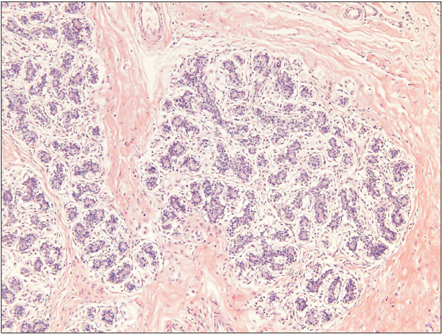Ann Surg Treat Res.
2015 Mar;88(3):166-169. 10.4174/astr.2015.88.3.166.
An idiopathic gigantomastia
- Affiliations
-
- 1Department of Surgery, Konkuk University Medical Center, Konkuk University School of Medicine, Seoul, Korea. 20110364@kuh.ac.kr
- 2Department of Plastic Surgery, Konkuk University Medical Center, Konkuk University School of Medicine, Seoul, Korea.
- 3Department of Pathology, Konkuk University Medical Center, Konkuk University School of Medicine, Seoul, Korea.
- KMID: 2266875
- DOI: http://doi.org/10.4174/astr.2015.88.3.166
Abstract
- Gigantomastia is a rare condition characterized by excessive breast growth. It has been reported that the majority of gigantomastia cases occur during either pregnancy or puberty. We were presented with a rare case of gigantomastia associated with neither pregnancy nor puberty, and successfully treated it with reduction mammaplasty and free nipple graft. This idiopathic gigantomastia is the very first case in Korea, and adds to the worldwide total of 9 reported cases.
Keyword
Figure
Reference
-
1. Taylor CJ, Chester DL. Bilateral breast reduction surgery in elderly women: a retrospective review of outcomes. J Plast Reconstr Aesthet Surg. 2012; 65:304–311.2. Beischer NA, Hueston JH, Pepperell RJ. Massive hypertrophy of the breasts in pregnancy: report of 3 cases and review of the literature, 'never think you have seen everything'. Obstet Gynecol Surv. 1989; 44:234–243.3. Dancey A, Khan M, Dawson J, Peart F. Gigantomastia: a classification and review of the literature. J Plast Reconstr Aesthet Surg. 2008; 61:493–502.4. Skillman J, Beechey-Newman N, Hamed H. Gigantomastia unrelated to pregnancy or puberty: a case report. Breast. 2002; 11:179–180.5. Chrominski W, Madej B, Maciejewski R, Torres K, Ciechanek R, Burdan F. A developmental anomaly of the mammary glands - gigantomastia. A case report. Folia Morphol (Warsz). 2003; 62:517–518.6. Ship AG. Virginal and gravid mammary gigantism: recurrence after reduction mammaplasty. Br J Plast Surg. 1971; 24:396–401.7. Shoma A, Elbassiony L, Amin M, Zalata K, Megahed N, Elkhiary M, et al. "Gestational gigantomastia": a review article and case presentation of a new surgical management option. Surg Innov. 2011; 18:94–101.8. Wolner-Hanssen P, Palmer B, Sjoberg NO, Astedt B. Gigantomastia. Acta Obstet Gynecol Scand. 1981; 60:525–527.9. Lanzon AE, Navarra SV. Gigantomastia in a patient with systemic lupus erythematosus successfully treated by reduction mammoplasty. Lupus. 2009; 18:1309–1312.10. Sakai T, Fujimori M, Tominaga Y, Kanai T, Ito K, Shingu K, et al. A case of unilateral gravid macromastia in 23-year-old Japanese woman associated with elevated serum CA19-9. Breast Cancer. 2005; 12:238–242.
- Full Text Links
- Actions
-
Cited
- CITED
-
- Close
- Share
- Similar articles
-
- Pseudoangiomatous Stromal Hyperplasia of the Breast in a Female Adolescent Presenting as Bilateral Gigantomastia
- Bilateral gigantomastia due to benign breast tumors: a case series and brief review focusing on bilateral diffuse pseudoangiomatous stromal hyperplasia
- Relapsed Bilateral Gigantomastia Caused by Pseudoangiomatous Stromal Hyperplasia after Reduction Mammoplasty
- Gestational Gigantomastia: A Case Report
- The Classification of Idiopathic Scoliosis





